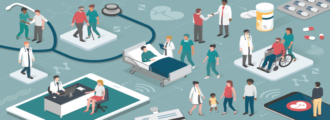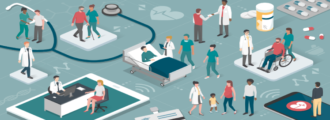In today’s healthcare environment, seamless data exchange and system interoperability are critical for delivering efficient and effective patient care. Interface engine software plays a pivotal role in facilitating this by enabling the integration of disparate healthcare systems, such as Electronic Health Records (EHRs), laboratory information systems, and billing platforms.
Key Takeaways:
- Enhanced Interoperability: Facilitates seamless communication between diverse healthcare systems, reducing data silos.
- Improved Efficiency: Automates data exchange processes, minimizing manual interventions and errors.
- Scalability: Adapts to growing organizational needs by supporting additional interfaces and data volumes.
- Compliance and Security: Ensures data exchanges meet regulatory standards and maintain patient confidentiality.
What is an Interface Engine?
An interface engine is a software application that helps healthcare organizations exchange healthcare data quickly and efficiently across multiple systems.
An interface engine is designed to be a centralized hub through which users can facilitate the transfer of healthcare data between electronic health records (EHRs), lab information systems, admission-data-transfer (ADT) systems, and more.
With interface engine functionality, your healthcare organization can seamlessly connect health IT and business systems, promote more efficient data sharing across business units, ensure accurate and on-time payment for patient care, reduce errors, improve visibility for application and seamless communication protocols, and enhance process efficiency.
How Do Interface Engines Work?
When an interface engine receives messages from multiple sources and systems, it leverages advanced routing capabilities to send them to the appropriate receiving application or system.
These interfaces act as a “go-between” for organizational data, and they ensure sensitive healthcare data is adequately exchanged and organizations remain compliant with messaging standards (i.e., Health Level Seven, or HL7).
By maintaining compliance with HL7 standards and leveraging a common data-sharing format, organizations can more efficiently import and export access systems, eliminate the need for manual data transfers, and save your organization time and money in the long run.
Key Capabilities of Interface Engines
- Allow easy access to data and resources within your system, application, or module.
- Automate core workflows to eliminate tedious manual tasks and save time for users.
- Leverage integration engine capabilities to improve decision-making processes and overall quality of care throughout the organization.
- Improve functionality across systems, applications, and platforms, including desktop, tablet, or mobile devices.
- Realize the benefits of existing systems without re-investment in other technologies to reduce costs in the long run.
- Extend the functionality of existing technology systems through planned and defined integrations without the need for new software.
- Provides support for internal and external databases and tools like the Microsoft SQL Server, QIE Database, MySQL, and more.
Point-to-Point vs. Interface Engine
When choosing the right approach to interface engines, it’s important to consider the possible ways to implement an HL7 interface between two systems or applications. Let’s take a closer look at each option.
Point-to-Point Communication
A point-to-point approach involves exchanging information between two sources or applications through a custom link (i.e., the interface used to connect the two software systems). With this approach, the two systems communicate independently of other applications, modules, or software systems.
Point-to-point communication is the most cost-effective approach for two static interfaces. Still, it does bring up a few issues with the lack of centralized monitoring, longer implementation times, and greater interface complexity.
Interface Engine
The interface engine approach involves using a middleware application to eliminate the need for individual connections between systems. It helps simplify the exchange of information between multiple data sources and systems.
With this approach, organizations can simplify the exchange of data across systems, track the flow of messages across the entire system, make changes in message or data format to reduce risk, and leverage flexibility to adapt to multiple different HL7 and XML message standards.
What is an HL7 Integration Engine?
The Health Level Seven, or HL7, integration engine is a central hub for receiving messages from other internal or external systems, routes them to the correct recipient, and sends them to the appropriate healthcare information systems.
HL7 integration engines provide the framework to help healthcare organizations exchange, integrate, manage, and retrieve health data, including HL7 messages, text files, and XML documents, between systems.
HL7 integration engines offer a few key features to outline, facilitate, and manage healthcare data exchange and communication across systems…
HL7 Message Viewer
With this feature, users can display messages in a flexible, expandable format and gain a better understanding of the data located within their HL7 messages.
HL7 Message Filtering
Message filtering allows users to create custom filters for their HL7 messages and easily leverage each filter to separate data elements according to organizational needs and requirements.
HL7 Message Transformation
The message transformation feature gives users the functionality needed to accommodate different versions of HL7, build custom HL7 message formats, and ensure the proper processing of data within your healthcare information systems.
Core Elements of the HL7 Integration Engine
1) Export endpoint, or the sending application involved in the transfer of data
2) Import endpoint, or the application on the receiving end of the data exchange
3) A stable method of movement for data formats between multiple applications
4) A method for managing the queuing messages
5) A plan for documenting the flow of messages between systems
Who Uses HL7 Interface Engines?
HL7 Interfaces are an essential key to success in data flow management in various organizations across the healthcare industry.
The HL7 interface engine is used in many organizations to…
- Manage core healthcare data in clinical information systems (CIS)
- Monitor integrations and regulations within the Center for Medicare and Medicaid Services (CMS)
- Connect core electronic health record (EHR) functionality with the CMS for improved data integrity and interoperability
- Leverage integrations with Health Information Exchanges (HIEs) to share data about patient care across multiple locations, facilities, and healthcare providers
The HL7 interface engine is designed specifically for the healthcare industry, and it provides the proper capabilities needed to connect legacy technology systems to modern applications or cloud-based systems through the standard messaging protocol.
Top 5 Advantages of the HL7 Interface Engine
HL7 integration engines play a pivotal role in improving the efficiency and quality of healthcare by enabling the seamless exchange of information among various systems and stakeholders.
Here are the main advantages of the HL7 integration engine for healthcare providers:
Interoperability:
HL7 integration engines enable interoperability by standardizing data formats and protocols. They ensure that various healthcare systems can communicate and share data seamlessly, reducing data silos and enhancing coordination among healthcare providers.
Data Mapping and Transformation:
These engines allow for the mapping and transformation of data from one format to another, which is particularly important in healthcare, where data often needs to be translated from one system’s format to another. This ensures data consistency and accuracy.
Workflow Automation:
HL7 integration engines support workflow automation, which can streamline and optimize various healthcare processes. For example, they can automate the transfer of lab results to electronic health records (EHRs) or alert clinicians to important events.
Real-time Data Exchange:
HL7 integration engines enable real-time healthcare data exchange, ensuring that critical patient records is available when needed. This is essential for decision-making, emergency situations, and timely patient care.
Scalability and Flexibility:
Integration engines are typically designed to be scalable and flexible, accommodating the changing needs of healthcare organizations. They can adapt to new data standards and protocols, support additional interfaces, and handle a growing volume of data as healthcare systems evolve.
How Can We Help?
Whether you need help outlining a plan to promote new interfaces across your organization, solving complex coding errors or issues within your system, managing multiple data sources in your existing system infrastructures, or anything in between, Surety Systems is here to help!
Our team of senior-level HL7 consultants has the technical skills, functional expertise, and real-world experience needed to lead you to success, regardless of the size, scale, or scope of your project needs.
Surety Senior HL7 Integration Engine Consultant
- 25+ years developing HL7 interfaces with Ensemble, e*Gate/DataGate, and Epic Bridges
- Epic Bridges Certified
- Experience with integrations that accompany Epic migrations and implementations
- In addition to Epic, experience integrating with McKesson, GE, and Allscripts products
Getting Started with Us
Interested in learning more about our healthcare interoperability consulting services or where our consultants can fit in your healthcare systems? Ready to get started on an HL7 integration project with one of our HL7 experts? Contact us today!




